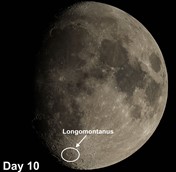 The week of November 23-29 Takes us from Lunar Day 9 to Full Moon. This week we will highlight the crater Longomontanus, viewable on Tuesday evening, Day 10, and the Arecibo radio telescope.
The week of November 23-29 Takes us from Lunar Day 9 to Full Moon. This week we will highlight the crater Longomontanus, viewable on Tuesday evening, Day 10, and the Arecibo radio telescope.
Longomontanus: [SW/P7; L=22°W] Take a look at Longomontanus and before reading further, decide if something seems slightly “wrong” about the crater.
 Longomontanus is an exception to the rule that crater age can be determined by their relative sizes. Larger craters are almost always older, and when there’s an overlap, smaller craters will intrude upon the rims and floors of their larger and older cousins. The east rim of Longo has superimposed itself on top of what is obviously an older but smaller crater.
Longomontanus is an exception to the rule that crater age can be determined by their relative sizes. Larger craters are almost always older, and when there’s an overlap, smaller craters will intrude upon the rims and floors of their larger and older cousins. The east rim of Longo has superimposed itself on top of what is obviously an older but smaller crater.
OF ADDITIONAL INTEREST IN SPACE:
Sad news about the Arecibo radio telescope. For more than 50 years, from its completion in 1963 until 2016, the Arecibo Observatory’s 1,000 ft. radio telescope was the world’s largest single-aperture telescope, but it has now become dangerously unstable. It is so dangerous it can’t even be repaired without endangering the lives of the workers, so it will be decommissioned.
======================
It is highly recommended that you get a copy of Sky and Telescope’s Field Map of the Moon, the very finest Moon map available for use at the telescope. It is available for $10.95 at www.skyandtelescope.com and on Amazon. All features mentioned in this blog will be keyed to the grid on the Field Map and will look like this: Plato: [NW/D9]
Credits:
Courtesy of Gray Photography of Corpus Christi, Texas
Lunar photos: NASA / USGS / BMDO / LROC / ASU / DLR / LOLA / Moon Globe. Used by permission
- Rupes Cauchy: A Best Known Fault on the Moon - July 22, 2024
- Moon Crater Schickard – Crater Floor has Stripes - July 15, 2024
- Moon Craters Langrenus and Vandelinus - July 8, 2024
